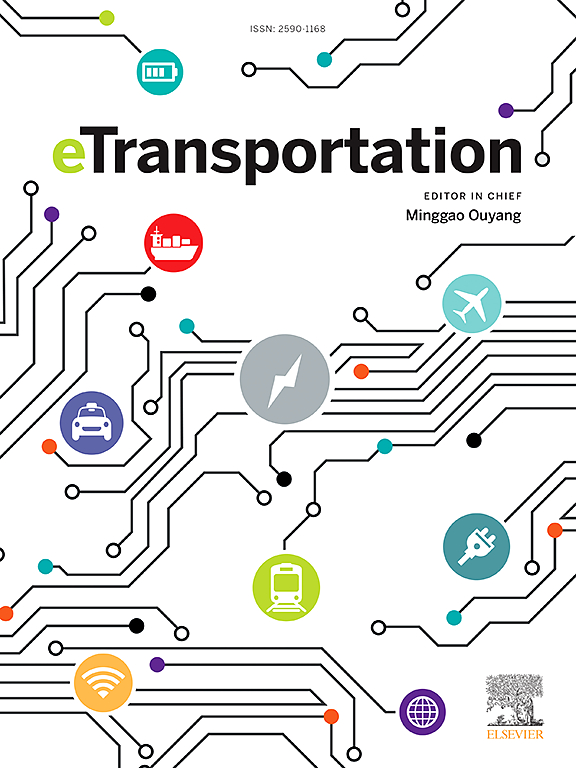Oxygen invasion behavior of anodic porous transport layer in polymer electrolyte membrane water electrolyzer: lattice Boltzmann method simulation
IF 17
1区 工程技术
Q1 ENERGY & FUELS
引用次数: 0
Abstract
The anode porous transport layer (PTL) is an important transport component of water and oxygen in polymer electrolyte membrane water electrolyzer (PEMWE), which plays a key role in the efficiency of hydrogen production. The three-dimensional (3D) pore structure of commercial sintered titanium (Ti) PTL is characterized by micro computed tomography (μ-CT). A 3D multiphase flow model of PTL is established based on lattice Boltzmann method (LBM). The influence mechanism of porosity, pore size, and thickness on oxygen invasion behavior in PTLs are systematically studied. The result shows that in commercial sintered Ti PTL, the growth rate of oxygen saturation decreases with transport process. When the porosity ranges from 20 % to 40 %, the dynamic transport of oxygen within the PTL exhibits a clear fingering behavior. When the porosity is 50 % and 60 %, the oxygen invasion rate in PTL is significantly accelerated. In addition, when the pore sizes are 3 and 6 μm, the transport process of oxygen is significantly hindered. The oxygen saturation curves with a pore size of 20 and 30 μm present the "W" form, which indicates that the local small pore throat structure will hinder the removal of oxygen. When the thickness is between 200 and 300 μm, the oxygen invasion process is hindered as the transport distance increases. The pore scale analysis of PTL structure optimization design provides a reference for the development of high-performance PEMWE.
聚合物电解质膜水电解槽中阳极多孔输运层的氧侵行为:晶格玻尔兹曼方法模拟
阳极多孔输运层(PTL)是聚合物电解质膜式电解槽(PEMWE)中重要的水氧输运组分,对制氢效率起着关键作用。采用微计算机断层扫描(μ-CT)对工业烧结钛(Ti) PTL的三维孔隙结构进行了表征。基于晶格玻尔兹曼方法(LBM)建立了PTL的三维多相流模型。系统研究了孔隙度、孔径和厚度对ptl中氧侵行为的影响机理。结果表明,在工业烧结钛PTL中,氧饱和度的增长速度随着输运过程的增加而降低。当孔隙度为20% ~ 40%时,氧在PTL内的动态输运表现出明显的指动行为。当孔隙度为50%和60%时,氧在PTL中的侵入速率明显加快。此外,当孔径为3 μm和6 μm时,氧的输运过程受到明显阻碍。孔径为20 μm和30 μm时的氧饱和度曲线呈“W”型,说明局部的小孔喉结构会阻碍氧的去除。当厚度在200 ~ 300 μm之间时,随着输运距离的增加,氧的入侵过程受到阻碍。PTL结构优化设计的孔隙尺度分析为高性能PEMWE的开发提供了参考。
本文章由计算机程序翻译,如有差异,请以英文原文为准。
求助全文
约1分钟内获得全文
求助全文
来源期刊

Etransportation
Engineering-Automotive Engineering
CiteScore
19.80
自引率
12.60%
发文量
57
审稿时长
39 days
期刊介绍:
eTransportation is a scholarly journal that aims to advance knowledge in the field of electric transportation. It focuses on all modes of transportation that utilize electricity as their primary source of energy, including electric vehicles, trains, ships, and aircraft. The journal covers all stages of research, development, and testing of new technologies, systems, and devices related to electrical transportation.
The journal welcomes the use of simulation and analysis tools at the system, transport, or device level. Its primary emphasis is on the study of the electrical and electronic aspects of transportation systems. However, it also considers research on mechanical parts or subsystems of vehicles if there is a clear interaction with electrical or electronic equipment.
Please note that this journal excludes other aspects such as sociological, political, regulatory, or environmental factors from its scope.
 求助内容:
求助内容: 应助结果提醒方式:
应助结果提醒方式:


